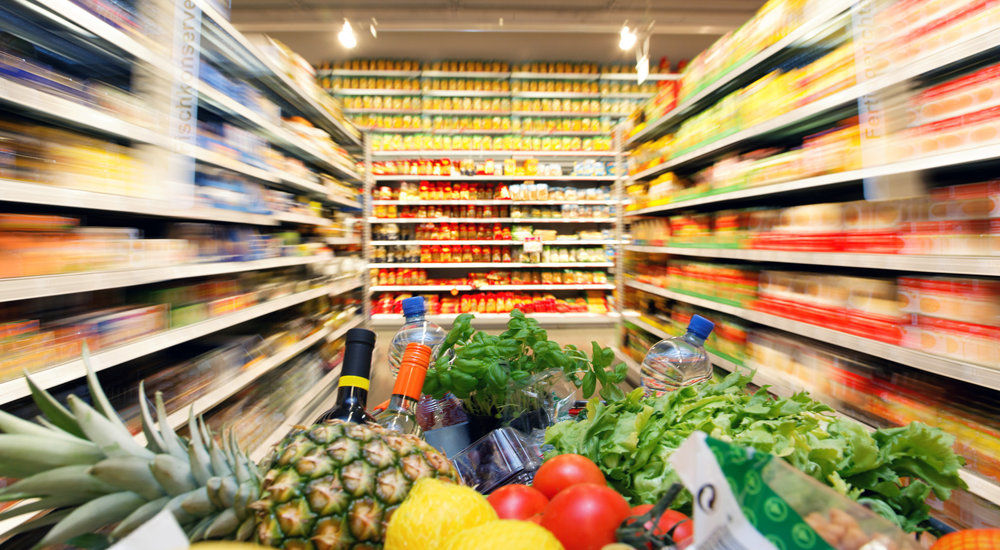Gaming my Grocery Shopping

My favorite high school job was as a grocery checker at the local Thriftway in Montgomery, NJ. This was in the days before bar-coding when cash registers were electric but still mechanical. Most items had price stickers but for those that didn’t, we checkers relied on our memories of the prices. Although this sounds lame, it was a rush to ring up items without stopping the noise of the cash register – it was almost musical. For those of you old enough to have gained proficiency on manual typewriters, the feeling is the same. I loved sweeping through an entire order without having to stop to check prices.
Another aspect of my grocery checking job was the bagging. At that time, all bags were paper and I learned to bag like items together, keep corners square, keep bags light enough that they didn’t rip, and orderly enough so they wouldn’t topple over. Plastic bags are an affront to all that is orderly in grocery bagging, not to mention the environmental carnage they cause. The introduction of reusable bags brings us back to a saner grocery bagging time. However, I find that baggers today don’t have my same sensibilities about the art of bagging. In fact, I may be alone in putting art and bagging in the same sentence.
Despite the previous paragraphs, I’m not a Luddite. Quite the opposite – I love technology, especially when I see an opportunity to use it to make changes for the better. The ScanIt technology in my local Giant supermarket supports shopper self-scanning as items are placed in the cart. Produce items that aren’t bar-coded must be weighed and a bar-coded sticker is printed that must be scanned.

When I tried to arrange my reusable bags so that I could bag as I scanned, the bags flopped over and violated my sense of order. It wasn’t until I discovered these Trolley Bags (https://www.amazon.com/gp/product/B01DFTOY18/ref=oh_aui_search_detailpage?ie=UTF8&psc=1) that I changed my thinking about self-scanning large amounts of groceries. These four bags have dowels that sit perpendicular across the sides of the cart and keep the bags open. In addition, the bags have Velcro along the dowels so that the bags connect together to maintain stability in the cart. The Velcro is also used to package them up when not in use. These bags make it easy to see around, group items together, and resurrect the art of bagging! The bags are sized differently so that large, light items go into the big bag and small, heavy items go into the small bag.

As an aside, if you have any pretensions of coolness, these bags will blow all of it out the window. Although these bags don’t exactly infantilize you, you’re more likely to be mistaken for a preschool teacher than a hipster (not that one can’t be both!) because of the primary colors of the bags. Before you ask the question, no, these bags do not come in black and you can’t upgrade to leather.

So what’s the point of all this? Does it save time? Time saving is a potential side-effect of this grocery shopping approach, but for me it’s not the point. It’s likely that the time saving is insignificant. It is much more efficient for a skilled checker to scan items en masse and punch in the vegetable codes that are committed to memory. The inefficiency in the traditional checkout method is having to unload the cart onto the conveyor belt and bag items after they’ve been scanned.
My checker friends in the supermarket are unenthused about this approach to shopping that cuts them out of the loop. Some have even said that they miss having me in their lines, which is nice of them to say considering that I’m just not much fun. When I don’t use the ScanIt devices, these bags are even useful for self-bagging when I see my checker friends.

Put an RFID reader in the bags so the grocery charges you as you exit the store. You bag once and un-bag at home. No checker line involved. You would have to weigh produce to get a code the bags can read.
Right on, Dario! I don’t think most stores are there yet with item-level RFID tagging. Seems like this is probably how things are done in the Amazon Go stores. I’ve also read about some Japanese markets that are experimenting with item-level checkout.
I’m putting these on my christmas list for next year!